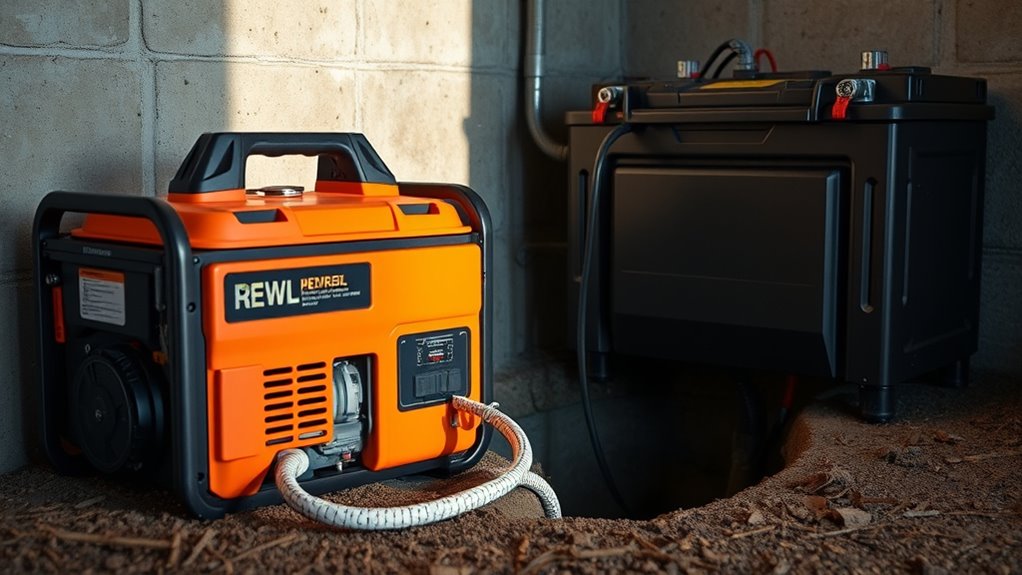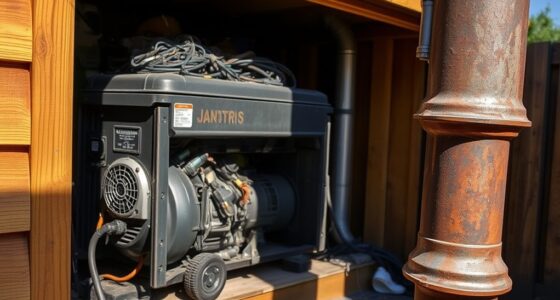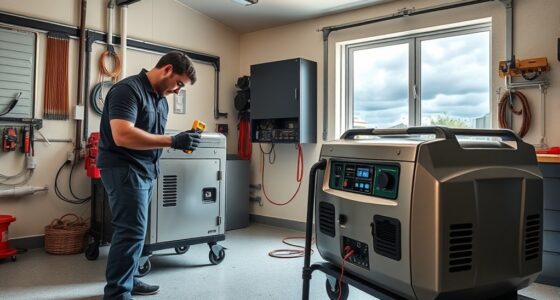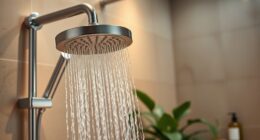To keep your sump pump running without grid power, consider installing a battery backup system, such as deep-cycle batteries paired with an inverter, or a water-powered pump that depends on municipal water pressure. You can also use a portable generator for extended outages. Regularly inspect, maintain, and test these backup systems to verify they work when needed. If you want detailed steps, keep going; there’s more to cover for reliable operation.
Key Takeaways
- Install a battery-powered backup pump with regular maintenance and testing to ensure reliable operation during power outages.
- Use an inverter system to convert stored DC battery power into AC for continuous sump pump operation.
- Connect a portable generator outside with proper wiring and transfer switches for extended backup power during outages.
- Employ a water-powered backup pump that operates on municipal water pressure, requiring no electricity or batteries.
- Regularly inspect, maintain, and test all backup systems to ensure readiness before storms or prolonged blackouts.
Understanding Your Backup Power Options
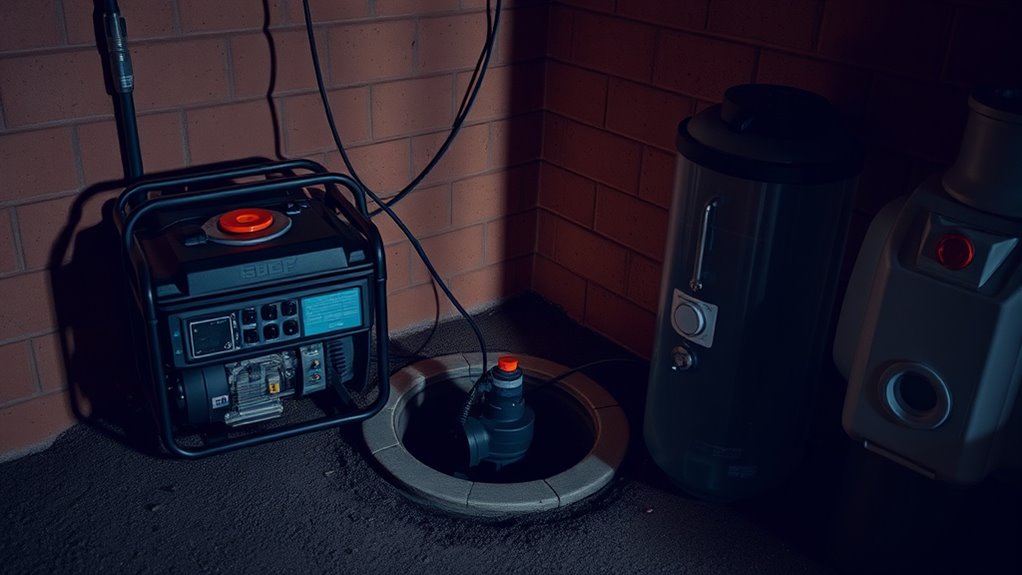
To keep your sump pump operating during power outages, it’s essential to understand your backup power options. Battery-powered backup pumps use 12-volt deep-cycle batteries, similar to those in boats or golf carts, costing $100 to $300+ depending on capacity. Batteries with 75Ah to 120Ah can run several hours, enough for days in typical blackouts. Most pumps discharge between 800 and 2,000 gallons per hour, ideal for flood-prone homes. These backup systems automatically activate via float switches when water rises, powering the primary pump. You also have auxiliary battery-operated pumps, which serve as a backup if the main pump fails. Proper maintenance of batteries and backup systems guarantees they operate reliably when you need them most. Automatic switch-over ensures seamless transition from grid power to backup, minimizing flooding risks. Understanding these options helps you plan effectively for power loss.
Selecting the Right Battery System for Your Needs
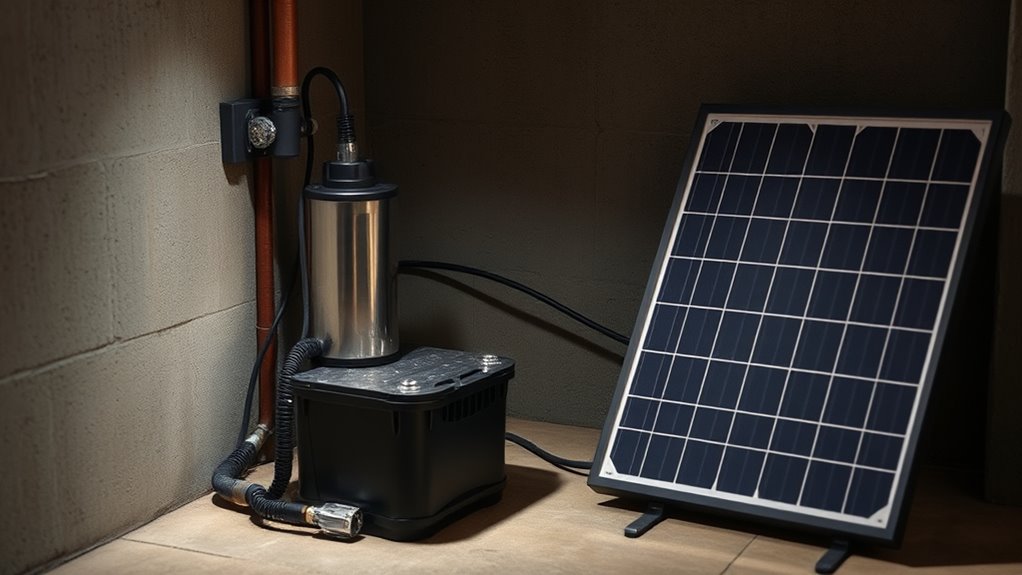
Choosing the right battery system for your sump pump backup depends on your specific needs, budget, and the typical duration of power outages in your area. Deep-cycle 12-volt marine batteries are common, offering reliable power over extended periods. AGM batteries provide faster recovery and last longer than flooded lead-acid types, making them a smart choice for durability. Your battery’s amp-hour (Ah) rating directly affects runtime; higher Ah batteries, like 75Ah, can run a sump pump for around 8.5 hours continuously, while smaller ones provide less. Keep in mind, larger batteries cost more and must fit within your system’s control box. Regular maintenance and replacement every 5-7 years are essential for ensuring your backup remains reliable when you need it most. Proper battery maintenance can significantly extend the lifespan and performance of your backup system. Additionally, selecting appropriate battery capacity based on your area’s typical power outage duration ensures optimal performance and reliability.
To optimize your setup, consider how battery storage capacity aligns with your backup needs and available space.
Installing a Battery-Powered Backup Pump
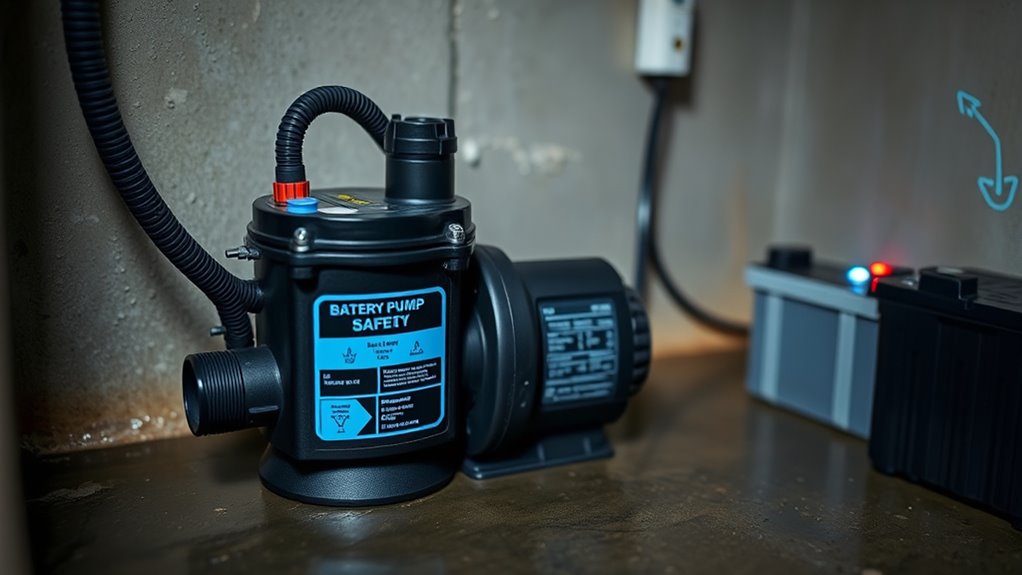
Installing a battery-powered backup pump involves replacing your primary sump pump with a secondary unit that operates independently of the electrical grid. You start by disconnecting the existing pump from power and the discharge pipe. Next, install a check valve on the primary pump with Teflon tape to prevent backflow. Position the backup pump alongside the primary pump on the sump pit floor, then connect the discharge pipes using PVC, glued joints, rubber connectors, and hose clamps. Attach the float switch about 6 inches above the water line on the discharge pipe, securing it with wire ties away from splashes. Place a deep-cycle marine battery in a protective box nearby, then connect low-voltage wiring with correct polarity. Proper wiring and secure connections are essential for safe and efficient operation. Additionally, ensuring the contrast ratio is sufficient can improve the visibility of your pump setup in low-light conditions. Regular testing of the system ensures that your backup pump works reliably when needed, giving you peace of mind during storms or power outages. To maximize the lifespan and performance of your backup system, consider inspecting the battery periodically and replacing it as recommended by the manufacturer. Incorporating vibration mitigation techniques can also help prolong the life of your pump components and reduce noise during operation.
Using Inverter-Based Power for Primary Pumps
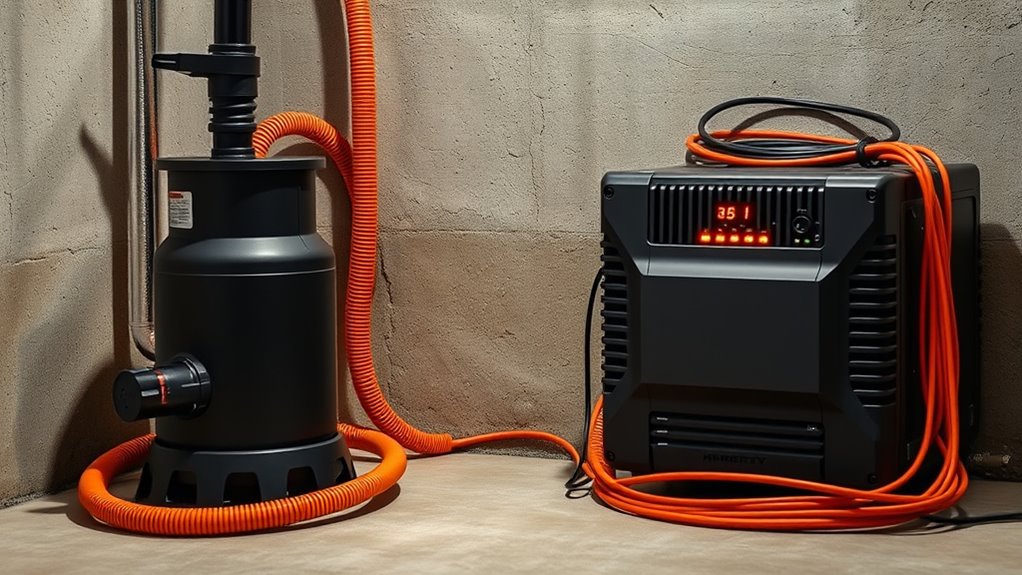
Using inverter-based power systems provides a reliable way to keep your primary sump pump running during power outages. These systems convert DC power from batteries into 120 VAC, supporting the pump’s full startup current, unlike most UPS units. They automatically detect power failures and switch seamlessly to battery power without manual input, ensuring continuous operation. To guarantee compatibility, the inverter’s capacity must match or exceed your pump’s motor draw, often up to 12.5 amps or more, with pure sine wave output preferred to prevent motor damage. Proper sizing of the inverter and batteries—typically 15-20 hours of runtime—is essential for reliable backup. Installation involves plugging your pump into the inverter, which is connected to the batteries, allowing for automatic operation during outages and quick return to grid power when restored. Additionally, selecting an inverter with surge capacity ensures it can handle the initial inrush current when starting the pump. Considering battery capacity and lifespan is also important to maintain consistent backup performance over time. Implementing proper wiring and safety measures helps prevent hazards and ensures system longevity.
Maintaining and Monitoring Battery Health
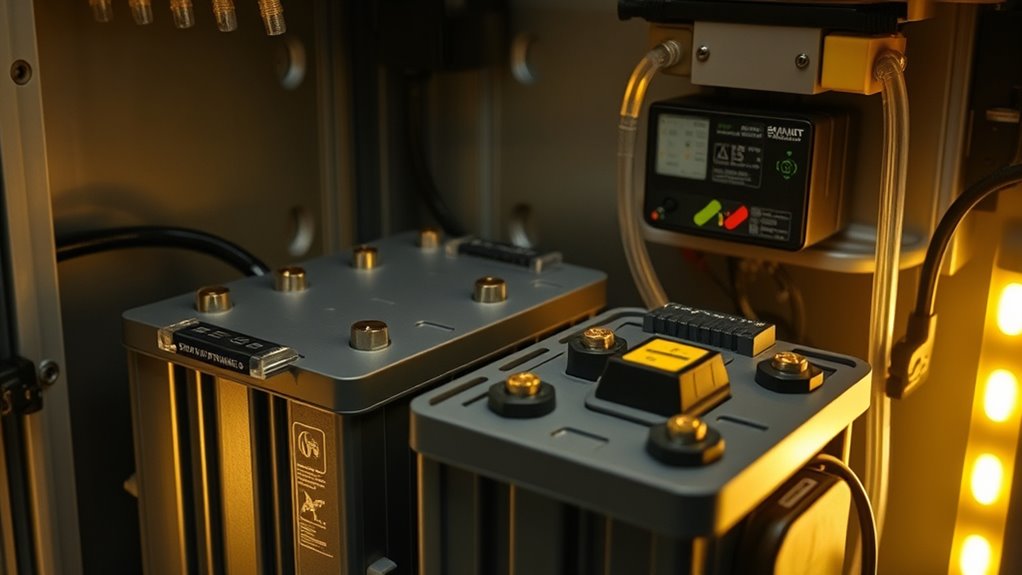
Regularly maintaining and monitoring your backup battery health is crucial to guarantee your sump pump stays operational during power outages. To do this effectively, perform tests every six months by unplugging the primary pump and adding water to the sump pit. Confirm the backup activates and removes water properly. Check that the float switch triggers only when water levels are high enough, adjusting it if needed. Listen for alarms indicating pump operation or failure. Inspect battery terminals for corrosion and clean them biannually for peak contact. Ensure the discharge line directs water away from your foundation during tests. Incorporating HEPA filtration principles can help keep your sump area free of dust and allergens that might interfere with sensor operation or maintenance routines. Additionally, monitoring AI safety measures can improve the reliability of automated monitoring systems used in sump pump maintenance. Regularly reviewing battery capacity ensures your backup system remains ready when needed, preventing unexpected failures.
Integrating Solar Power for Sump Pump Backup
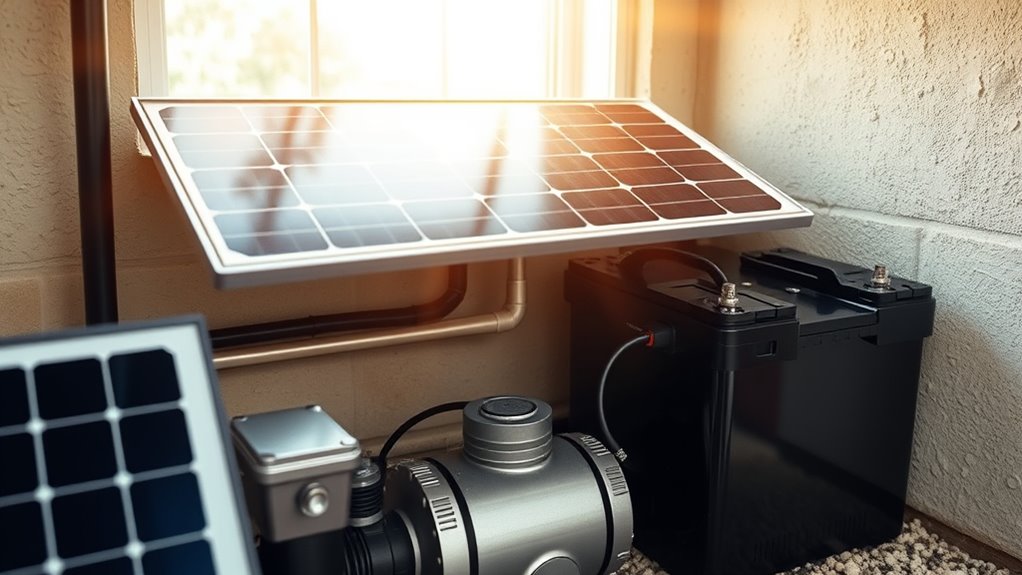
To keep your sump pump running during outages, you’ll need to size your solar panels and batteries appropriately. Ensuring your panels generate enough power and your batteries stay charged is key to reliable operation. Proper planning now means your system will perform seamlessly when you need it most. Additionally, understanding backup power options such as solar generators and portable power stations can help you choose the best solution for your needs. Being aware of system capacity requirements ensures your setup can handle the sump pump’s energy demands efficiently. Incorporating solar energy storage solutions can further enhance the reliability of your backup system during extended outages, especially as advances in modern toilet technology continue to improve efficiency and performance.
Solar Panel Sizing
Determining the right size for your solar panel array is essential to guarantee your sump pump keeps running during power outages. To do this, first check your pump’s wattage and estimate its daily energy needs, factoring in surge power during startup. Then, divide this total by your location’s peak sunlight hours to size your panels properly. Keep in mind system losses—typically 10-20%—and include these in your calculations. Incorporating AI security measures can help monitor your solar system’s performance and detect potential issues proactively, ensuring reliable operation. Additionally, understanding farmhouse bedroom design principles can enhance your outdoor space, creating a cozy and inviting environment that complements your solar setup. When selecting panels, consider using weather-resistant panels rated IP65 or better for outdoor use to withstand the elements. Consider these points: – Match panel wattage to your daily energy requirement divided by peak sun hours – Connect panels in series or parallel to meet voltage and current needs – Use weather-resistant panels rated IP65 or better for outdoor use – Adjust panel angles seasonally for maximum sunlight capture
Battery Charging Strategies
Integrating solar power into your sump pump backup system allows you to recharge batteries independently of the grid, guaranteeing reliable operation during outages. You’ll use photovoltaic panels paired with charge controllers—either PWM or MPPT—to optimize energy harvest and prevent overcharging. Proper charge regulation extends battery life, especially with lithium-ion or sealed lead-acid batteries. To keep your system effective, consider local sunlight levels and battery capacity; larger batteries provide longer backup times. Regular maintenance, like cleaning terminals and checking water levels, helps prevent corrosion. When designing your system, verify the inverter matches your sump pump’s power needs, and include automatic transfer switches for seamless switching between solar, battery, and grid power. This setup guarantees your sump pump stays operational, rain or shine. Automation technologies can further enhance your system’s efficiency by enabling remote monitoring and control.
Using Water-Powered Backup Pumps as an Alternative
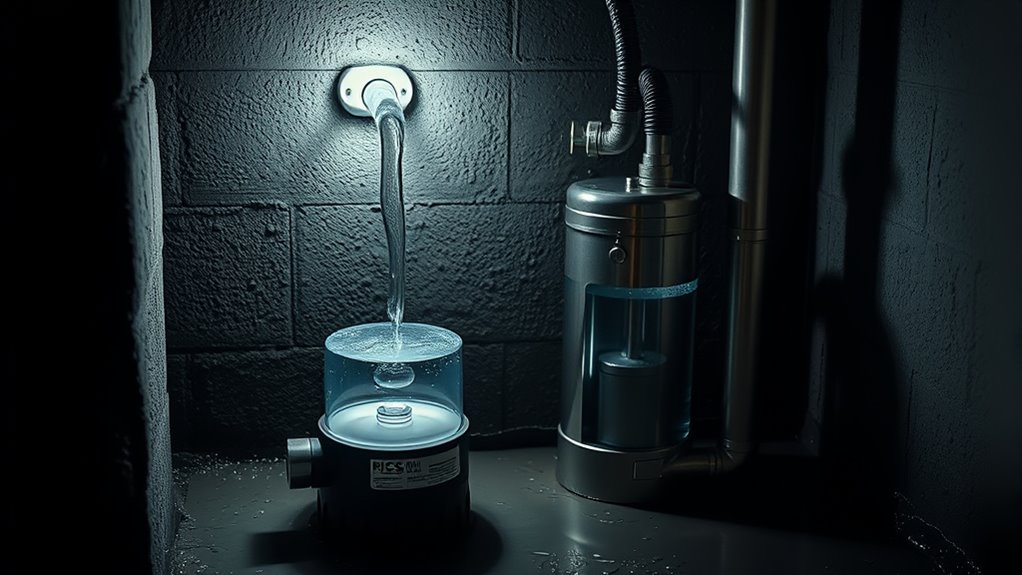
When the power goes out, water-powered backup sump pumps offer a reliable alternative to traditional electric or battery systems. They operate solely on municipal water pressure, requiring no electricity or batteries. When sump water rises, a float lifts, opening a valve that uses city water to create suction and pump sump water outside. This automatic system activates and shuts off based on water levels, ensuring continuous protection without manual intervention.
- No batteries to charge or replace, eliminating maintenance.
- Unlimited run time as long as municipal water pressure is steady.
- Longer warranties and higher reliability ratings.
- Mounts easily in various positions, including ceiling installations for safety.
These pumps deliver consistent performance, even during extended outages or storms.
Connecting a Generator for Extended Power Outages
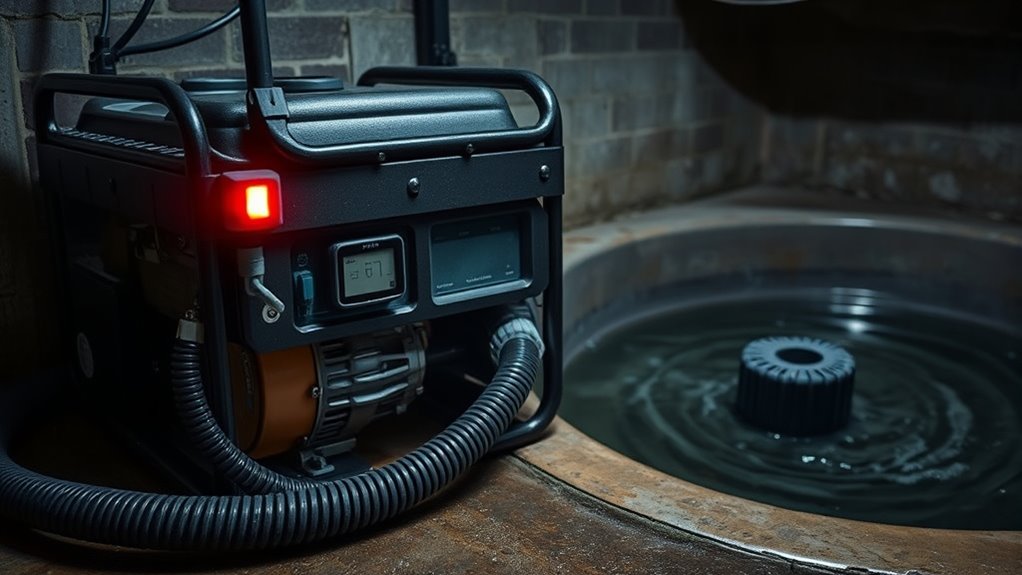
Looking to keep your sump pump running during extended power outages? Connecting a generator is a reliable option. First, select a portable generator rated between 1000-3000 watts, enough for your pump’s startup and continuous use. Position it outside at least 10 feet away to avoid carbon monoxide risks, and use a heavy-duty extension cord to connect the pump safely. Guarantee the generator is fueled with fresh gas and maintained regularly. For added safety, consider installing a transfer switch that connects directly to your home’s electrical panel, preventing backfeed. Use appropriate wiring, weatherproof connectors, and proper grounding. Here’s a quick overview:
| Step | Key Action | Safety Tip |
|---|---|---|
| Choose a generator | Match wattage to pump needs | Keep outside, 10 ft away |
| Connect with extension cord | Use rated, sufficient length | Avoid household outlets |
| Install transfer switch | Hire electrician for safety | Isolates power from grid |
| Wiring considerations | Use proper gauge and weatherproofing | Proper grounding essential |
Ensuring Proper System Maintenance and Testing
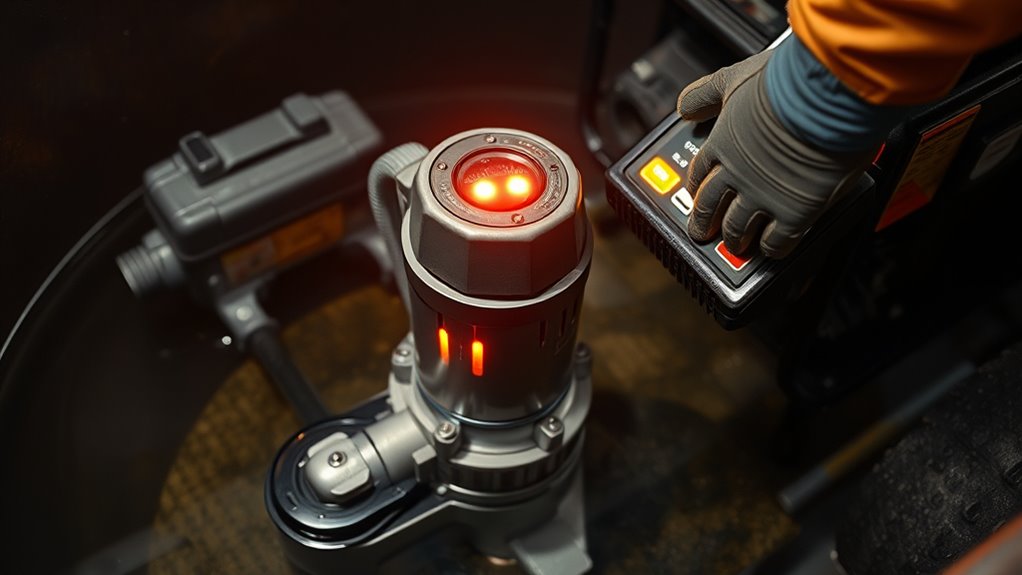
Regular maintenance and testing are essential to guarantee your sump pump operates reliably when you need it most. You should conduct annual tests before heavy rain seasons by slowly pouring water into the sump pit to check if the pump activates and discharges water properly. Test your backup system by unplugging the main pump and confirming the backup kicks in and pumps water effectively. Regularly monitor water levels during wet weather to catch early signs of rising water. Also, frequently check the float switch, since it’s a common failure point that can cause continuous running or no operation at all. Additionally, verify that the discharge pipe directs water at least 20 feet away from your foundation and is free of clogs to prevent water from re-entering your basement.
Tips for Maximizing Backup System Reliability
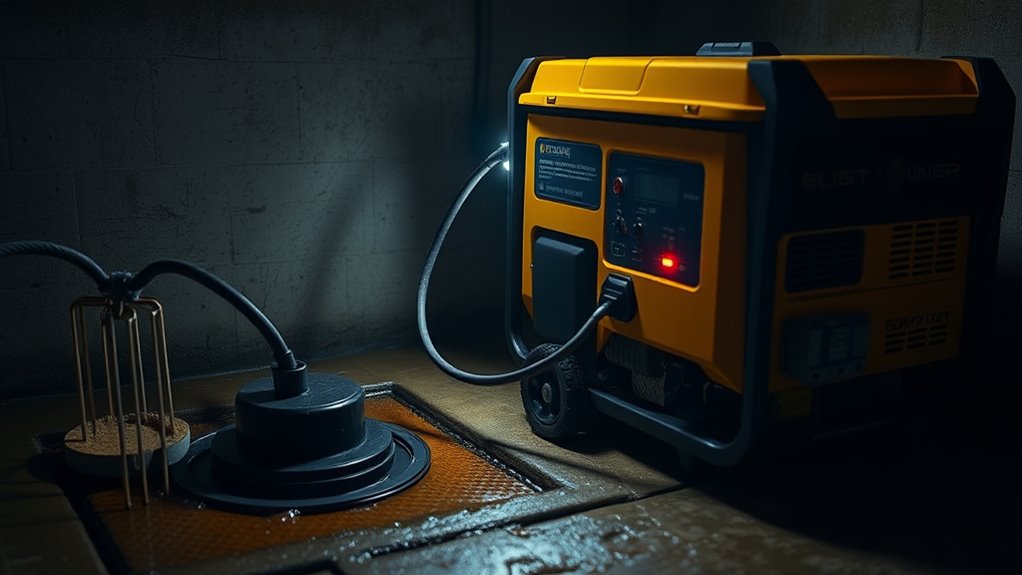
To keep your backup system reliable, you need to regularly test it and perform maintenance tasks. Scheduling routine inspections and battery checks helps catch issues early and guarantees everything works when needed. Proper placement of your components also protects them from environmental damage and simplifies access for maintenance.
Regular System Testing
Consistent testing of your backup sump pump system is crucial to guarantee it will operate effectively when you need it most. Regular checks ensure you catch potential issues early, preventing failure during heavy rains or outages. Test your system at least once a year by unplugging the primary pump and fully discharging the battery. For water-powered backups, test semi-annually by shutting off the main water supply and running the pump. Follow manufacturer guidelines for generator systems, testing more frequently during storm seasons. Monthly checks during storms help identify problems before an emergency. Always perform tests before and after heavy rain, storms, or power outages. This proactive approach maintains reliability and ensures your backup system is ready when it counts.
- Manually activate pumps by filling the sump pit with water
- Verify automatic shut-off and float switch operation
- Inspect discharge pipes for leaks or blockages
- Use smart monitors to automate and verify backup engagement
Battery Maintenance Schedule
Maintaining your backup sump pump’s battery is essential for reliable operation during power outages. You should inspect battery terminals for corrosion at least twice a year and clean them with a wire brush or terminal cleaner to guarantee strong connections. Remove and rinse battery fluid sensors and caps to prevent residue buildup, then dry and replace them. Check fluid levels in flooded lead-acid batteries during biannual maintenance to maintain proper electrolyte balance. Regularly clean battery posts and cable connectors to prevent corrosion that hampers power transfer. Test the battery’s capacity quarterly to confirm it retains enough charge. Replace batteries every 3 to 5 years or sooner if testing shows diminished performance. Keeping a maintenance log helps track battery health and anticipate replacements, ensuring your backup remains ready when needed.
Proper System Placement
Proper placement of your sump pump system is essential for reliable operation, especially during power outages. You want to make certain it’s positioned where it can effectively intercept water and stay protected. Install your sump pump at the basement’s lowest point, ideally in corners near foundation footings, to catch water early and prevent flooding. Choose a low-traffic area to avoid accidental damage and make sure the sump pit is accessible for inspection and maintenance.
- Place the pump at the basement’s lowest point or corner
- Position near foundation footings for better water interception
- Keep the sump pit accessible for easy checks
- Select a low-traffic, protected location to prevent damage
Frequently Asked Questions
How Long Can a Typical Battery Backup System Run During a Power Outage?
A typical battery backup system can run your sump pump for about 5 to 7 hours continuously during a power outage. If the pump operates intermittently, it might last 1 to 3 days, depending on water inflow. Larger batteries can extend this up to around 53 hours under ideal conditions. Keep in mind, battery age, capacity, and environmental factors influence the actual runtime you’ll get.
What Safety Precautions Should I Take When Installing a Backup Sump Pump System?
When installing a backup sump pump system, you should unplug the main pump beforehand to avoid electric shock. Use a grounded outlet and avoid smoking or sparks near batteries. Wear protective gear when handling batteries, and guarantee proper ventilation. Mount the control unit securely, keep cords organized, and check for leaks. Regularly inspect batteries and connections, and always disconnect power before maintenance to keep yourself safe during installation.
How Often Should I Test My Sump Pump Backup to Ensure It Works Properly?
Think of your backup sump pump as a loyal guardian standing watch. You should test it at least once a year by unplugging your main pump and running the backup until the battery’s drained. Water-powered backups need testing every six months. Regular checks make certain your protector remains vigilant, ready to spring into action when heavy rains threaten, giving you peace of mind that your home stays dry no matter what.
Can I Upgrade My Existing Sump Pump System to Include Backup Power?
Yes, you can upgrade your existing sump pump system to include backup power. First, choose the right backup option, like a battery-powered or inverter system, based on your needs and space. Then, install the backup system alongside your current pump, verifying compatibility and proper sizing. Regularly test and maintain it to ensure reliable operation during outages, giving you peace of mind against flooding.
What Are the Signs That My Backup Battery Needs Replacement?
You’ll notice your backup battery needs replacing if voltage drops below 12.3 volts, or if you see corrosion, cracks, or leaks on the battery. Frequent alarms, strange noises, or the pump running nonstop also signal battery failure. If your system struggles during outages, or if warning lights appear often, it’s time for a new battery. Regular checks help prevent flooding by ensuring your backup power stays reliable.
Conclusion
Did you know that over 60% of basement flooding incidents happen during power outages? By understanding your backup options and regularly maintaining your system, you can keep your sump pump running when it matters most. Whether you choose batteries, generators, or water-powered backups, staying prepared guarantees peace of mind. Take proactive steps today to protect your home from unexpected floods—reliable backup systems are your best defense against costly water damage.

